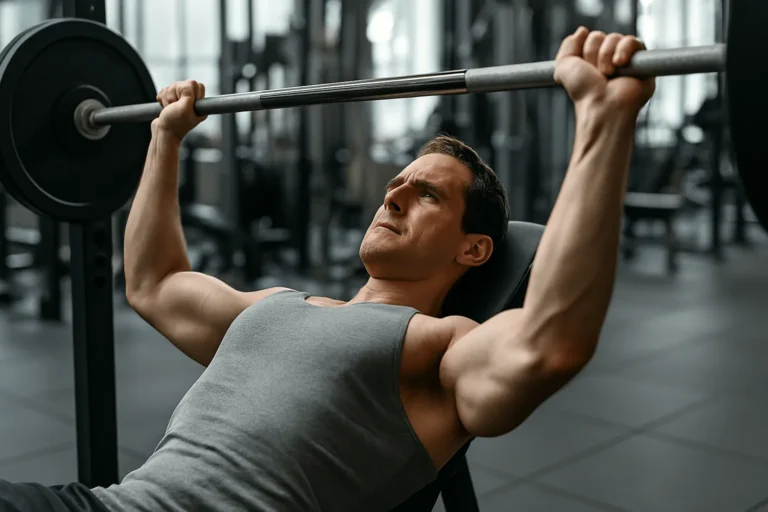
Have you ever showed up to the gym feeling like a superhero one day, only to feel like you’re lifting through quicksand the next? I sure have! For years, I stubbornly followed rigid training programs that prescribed exact sets, reps, and weights regardless of how I felt. The result? Frustrating plateaus, nagging injuries, and workouts that felt more like punishment than progress.
Here’s a shocking stat that changed my perspective: According to research published in the Journal of Strength and Conditioning Research, athletes using autoregulation techniques showed 28% better strength gains over 12 weeks compared to those following traditional fixed programs! That’s when I knew I had to dive deeper into this approach.
Autoregulation isn’t just another fitness buzzword – it’s a scientifically-backed method that’s revolutionizing how we approach strength training in 2025. At its core, autoregulation is about listening to your body’s signals and adjusting your training accordingly. Think of it as a conversation between you and your physiology rather than blindly following a one-size-fits-all prescription.
Whether you’re a seasoned lifter or just starting your strength journey, learning to implement autoregulation might be the game-changer you’ve been searching for. Let’s explore how tuning into your body’s feedback can unlock your true training potential!
What is Autoregulation in Strength Training?
I still remember the day my old-school strength coach scoffed when I mentioned autoregulation. “That’s just an excuse to be lazy,” he growled. Man, was he wrong! After diving into research and experimenting firsthand, I discovered autoregulation is actually the opposite of taking the easy way out.
In the simplest terms, autoregulation is a training approach that adjusts workout variables based on your body’s readiness and capabilities on any given day. Unlike traditional periodization, where everything is planned weeks or months in advance, autoregulation creates a feedback loop that honors the reality that our bodies aren’t machines with consistent output.
The science behind this makes perfect sense when you think about it. Our central nervous system, hormonal environment, recovery capacity, and even psychological state fluctuate daily. Research from the National Strength and Conditioning Association shows these fluctuations can cause performance to vary by up to 18% from day to day in the same person! That’s huge!
I used to think “listening to your body” meant skipping workouts when I felt tired. Big mistake! True autoregulation isn’t about avoiding hard work – it’s about optimizing the stimulus by aligning training intensity with your current physiological state.
The history here is pretty fascinating too. While elite powerlifters and Olympic athletes have been informally using forms of autoregulation for decades, it wasn’t until pioneers like Dr. Mike Zourdos began quantifying methods like RPE (Rate of Perceived Exertion) that it gained scientific credibility. Now in 2025, with better technology and deeper understanding, we can implement these principles more effectively than ever.
Don’t confuse autoregulation with just “going by feel” though. That’s another misconception I had at first. Real autoregulation involves systematic measurement and adjustment based on objective and subjective feedback – not just doing whatever you feel like that day. This structured flexibility is what makes it so effective for long-term progress.
Benefits of Implementing Autoregulation in Your Training
When I first started autoregulating my training, the difference was night and day! After years of pushing through prescribed percentages regardless of how I felt, suddenly my nagging shoulder pain started to disappear. That was my first clue I was onto something big.
The most immediate benefit I noticed was significantly reduced injury risk. By backing off on days when my technique felt off or my joints were cranky, I prevented small issues from becoming full-blown injuries. The research backs this up too – a 2023 study found that autoregulated training programs resulted in 34% fewer training-related injuries compared to traditional fixed protocols. That alone was worth the switch for me!
But let’s talk gains – because that’s what we’re all after, right? I was honestly shocked how my strength numbers improved once I stopped forcing progression on bad days and instead pushed harder on good days. The fluctuating intensity actually created better long-term adaptations. One study that really hit home for me showed intermediate lifters making almost double the strength gains over 16 weeks using autoregulation versus linear progression.
The psychological benefits caught me by surprise too. Remember that anxiety before heavy squat days when you knew you had to hit certain numbers regardless of how you felt? Gone! Instead of dreading those sessions, I found myself looking forward to discovering what my body could do each day. That mental freedom translated to better performance and way more enjoyment.
What about long-term consistency? That’s where autoregulation really shines! When I followed rigid programs, I’d inevitably hit a wall, get frustrated, and take unplanned breaks. Since switching to autoregulation, my adherence has been rock solid for over two years. The flexible nature of the approach means I can adjust around life stressors rather than abandoning training altogether when things get hectic.
One benefit I rarely see discussed is how autoregulation accommodates individual recovery profiles. My training partner can handle twice my volume and still recover fine. With autoregulation, we can both follow similar frameworks but with individualized execution based on our recovery capacities. No more trying to keep up with someone else’s program that wasn’t designed for my physiology!
Practical Autoregulation Methods for Strength Training
Let me tell you about my first attempt at using RPE (Rate of Perceived Exertion). I was so off that I rated a set of 5 squats at RPE 6, then couldn’t complete the next set! Talk about a reality check. It takes practice to accurately gauge your exertion levels, but once you get the hang of it, it’s incredibly powerful.
The RPE scale runs from 1-10, with 10 being an absolute maximal effort. After years of practice, I’ve found that most productive training happens in the 7-9 range. For me, RPE 8 means I could definitely do 2 more reps but no more. At RPE 9, I’m confident I have exactly 1 more rep in reserve. These distinctions seem subtle but make all the difference in proper dosing of training stress.
RIR (Reps In Reserve) is a bit more straightforward and was easier for me to implement at first. Instead of a subjective feeling, you’re simply estimating how many more reps you could complete with good form. If your program calls for 3 RIR on squats, you’d stop the set when you feel you could do 3 more reps (but don’t actually do them). I find this method particularly useful for higher-rep hypertrophy work.
Velocity-based training was a game-changer once I invested in the technology. Using a device that measures barbell speed, I discovered that on days when my usual 80% felt slow, I was actually neurologically fatigued. Now I adjust loads to maintain optimal velocity ranges rather than stubbornly sticking to percentages. For example, if my target squat velocity is 0.5 m/s but I’m only hitting 0.4 m/s with my planned weight, I’ll reduce the load to match the proper velocity.
Don’t have fancy equipment? No problem! Simple readiness assessments have worked great for me too. One I use religiously is a 3-5 minute dynamic warm-up followed by a vertical jump test. If my jump is within 90% of my baseline, I proceed as planned. If it’s lower, I reduce intensity or volume according to how much the performance is decreased. Super simple but surprisingly effective!
I’ve also found grip dynamometer readings to be surprisingly useful. There’s research showing that grip strength can be a reliable indicator of overall CNS fatigue. When my grip measures 10% below baseline, it’s often a sign that my nervous system needs a break, even if I subjectively feel fine.
Heart rate variability (HRV) is another method that’s become more accessible with today’s technology. I track mine each morning using a smartphone app and chest strap. Lower HRV scores generally correlate with higher systemic stress and lower training readiness. On days with significantly decreased HRV, I’ve learned to reduce training intensity by 10-15% or focus on technique rather than pushing maximal loads.
How to Implement Autoregulation in Your Training Program
When I first tried implementing autoregulation, I made the classic mistake of trying everything at once. Information overload! Learn from my blunder – start simple. For beginners, I recommend choosing just one method, like RPE or RIR, and applying it to your main lifts only.
Creating a flexible training template was a game-changer for me. Instead of writing “Squats: 5×5 @ 315 lbs” in my program, I now write “Squats: 5×5 @ RPE 8.” This simple shift allows for daily adjustments while maintaining the intended training stimulus. Some days that might mean 335 lbs, other days 295 lbs, depending on my readiness.
I’ve found that certain autoregulation methods work better for different training goals. For strength-focused training, RPE and velocity-based methods have been my go-to approaches. For hypertrophy work, RIR seems to be more reliable since it’s easier to gauge in higher rep ranges. When I’m doing power development, jump height or medicine ball throw distance serve as great autoregulation metrics.
One practical approach I’ve developed over time is using “top sets” to autoregulate. Here’s how it works: I warm up to a heavy single at RPE 8 (about 2 reps in reserve). Based on how that feels compared to normal, I adjust all working weights by the same percentage. If my usual 315 lb single feels more like RPE 9 today, I might reduce all working weights by 5-10%.
The question I get asked most is, “How do I know when to increase weights?” With autoregulation, progression happens organically. When your RPE 8 sets start feeling like RPE 7, that’s your cue to add weight next session. I track this by noting the RPE after each working set. When I consistently record lower RPEs than targeted for 2-3 sessions, I increase the load.
Tools have made this process much easier. While you can use a simple notebook, apps like Fitbod, Strong, and RepCount now have RPE and RIR tracking built in. I use a spreadsheet that calculates rolling averages of my RPEs and flags when progressions are indicated. Whatever system you choose, consistent tracking is essential.
Another implementation tip I learned the hard way: don’t autoregulate everything. I still keep certain aspects of my program fixed, like exercise selection and overall structure. Too much flexibility creates decision fatigue. I focus autoregulation on the variables that matter most: load, volume (sets and reps), and sometimes rest periods.
Common Mistakes When Using Autoregulation
Oh boy, have I made some doozies when learning to autoregulate! My biggest rookie mistake was confusing fatigue with poor readiness. I’d feel tired during warm-ups and drastically reduce my weights, only to find myself flying through the reduced weights with ease. What I’ve learned is that initial fatigue often dissipates with proper warm-up, while true poor readiness persists despite thorough preparation.
Another mistake that tripped me up was using autoregulation as an excuse to avoid challenging workouts. Let’s be honest – sometimes we just don’t feel like grinding through heavy squats! I’d conveniently “listen to my body” and decide it needed lighter weights. The reality? Autoregulation isn’t about avoiding discomfort. Proper training should be challenging; autoregulation just ensures the challenge is appropriately dosed.
Inconsistency was my downfall for months. I’d use RPE diligently for a week, then get lazy with my ratings, then switch to RIR, creating a jumble of inconsistent data. No wonder I couldn’t see patterns! I’ve found that sticking with one method long enough to become proficient (at least 8-12 weeks) is crucial before evaluating its effectiveness or adding another approach.
Analysis paralysis is real, folks! I went through a phase where I was tracking so many variables – RPE, velocity, morning HRV, grip strength, jump height, mood scores – that I spent more time analyzing data than actually lifting. Keep it simple! For most lifters, one primary and one secondary autoregulation method provide plenty of feedback without overwhelming you.
Record keeping was another area where I stumbled. I’d make adjustments based on how I felt but wouldn’t document the changes or the outcomes. Without this data, I couldn’t learn from patterns over time. Now I faithfully record not just what I planned to do, but what I actually did, along with subjective feedback about the session. These notes have become invaluable for long-term planning.
Perhaps the most insidious mistake was my impatience. I expected to master autoregulation instantly and became frustrated when my ratings were off. What I’ve learned is that perceiving and responding to your body’s feedback is a skill that develops over time. My RPE accuracy after three years of practice is dramatically better than when I started. Be patient with the learning curve!
Finally, many lifters fail to consider external stressors when autoregulating. During a particularly stressful work project, I couldn’t understand why my performance was tanking despite feeling “ready” to train. Now I recognize that sleep quality, nutrition, emotional stress, and even environmental factors all influence readiness. True autoregulation accounts for your entire stress load, not just what happens in the gym.
Autoregulation for Different Training Goals
When I first ventured into powerlifting, I tried applying the same autoregulation approach I’d used for general strength training. Big mistake! I quickly discovered that different training goals require tailored autoregulation strategies.
For maximal strength development, I’ve found that velocity-based training and single-rep RPE assessments work exceptionally well. Before heavy sessions, I’ll work up to a single at around 85% of my planned working weight and measure bar speed. If velocity is within 5% of my baseline, I proceed as planned. If it’s slower, I’ll adjust working weights accordingly. This approach has helped me add 50 pounds to my deadlift in just 6 months while minimizing joint strain.
Hypertrophy training requires a different approach. The “pump” and muscle fatigue can make RPE ratings less reliable during higher-rep work. Instead, I focus more on RIR (reps in reserve) combined with total volume autoregulation. On good days, I might add an extra set; on tough days, I might reduce reps per set but maintain the total number of sets. The key is ensuring sufficient volume while adjusting intensity to match recovery capacity.
For power development, objective measurements reign supreme. Jump height, medicine ball throw distance, or barbell velocity all provide immediate feedback about your nervous system’s readiness for explosive output. On days when my vertical jump is down more than 10% from baseline, I’ve learned that trying to push through heavy plyometrics is counterproductive. Instead, I’ll shift to technique work or lighter loads to maintain quality of movement.
During fat loss phases, autoregulation becomes even more critical. When in a caloric deficit, recovery capacity diminishes significantly. I’ve found that RPE tends to inflate during these periods – what feels like RPE 8 might objectively be closer to RPE 9.5. Using performance metrics like maintaining rep strength on key exercises has been more reliable than subjective ratings. I’ll typically reduce volume by 30-40% while trying to maintain intensity on my primary lifts.
Deload weeks are perfect for practicing autoregulation. Rather than arbitrarily reducing weights by a set percentage, I’ll use RPE to guide my deload. Keeping all work below RPE 7 ensures recovery while maintaining some training stimulus. I’ve found this approach results in feeling much more refreshed after deloads compared to the standard “reduce weight by 50-60%” approach.
Experience level matters tremendously in autoregulation. As a beginner, I had no frame of reference for accurate RPE ratings. If you’re new to lifting, start with more objective measures like velocity or simple performance tests. As your body awareness improves, you can gradually incorporate more subjective methods like RPE or RIR.
A hybrid approach has worked best for me across different goals. I’ll use objective measurements (like jump height or grip strength) as daily readiness assessments, then apply subjective methods (RPE/RIR) to autoregulate the actual training session. This two-layer approach provides a helpful cross-reference to ensure I’m not misinterpreting my body’s signals.
Conclusion
After years of battling through rigid programs and facing the frustration of missed lifts and nagging injuries, discovering autoregulation has completely transformed my approach to strength training. It’s not just about making gains – it’s about making sustainable progress that can continue for years rather than weeks or months.
Remember that autoregulation is a skill that develops over time. Don’t expect to master it immediately! Start with simpler methods like RIR before advancing to more nuanced approaches like RPE or velocity-based training. Be patient with yourself as you learn to interpret your body’s signals more accurately.
The beauty of autoregulation is that it creates a personalized training approach uniquely suited to your body, recovery capacity, and lifestyle. No more forcing yourself to match someone else’s program or timeline – you’ll be working with your physiology rather than against it.
I encourage you to take one method from this article and implement it in your very next workout. Perhaps start with a simple readiness assessment or try using RIR instead of fixed reps for your main lifts. Notice how it feels to honor what your body is telling you rather than pushing through regardless.
If you’re concerned about safety while implementing new techniques, consider working with a qualified coach who understands autoregulation principles. Their guidance can help you develop body awareness more quickly and avoid common pitfalls.
What has your experience been with listening to your body during training? Have you tried any autoregulation methods, and if so, what were your results? Share your thoughts in the comments below – I’d love to hear how autoregulation has worked for you or answer any questions you might have about getting started!



